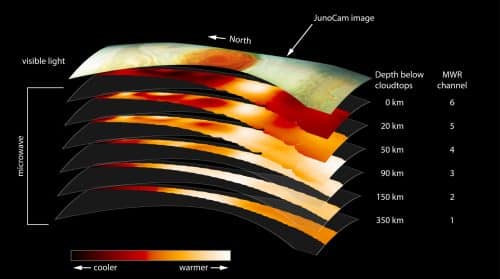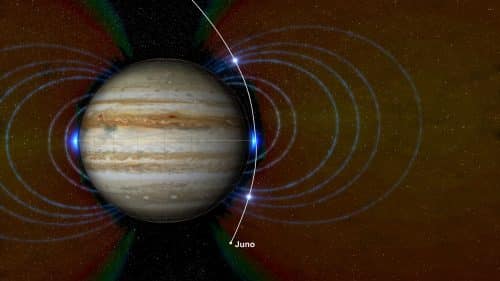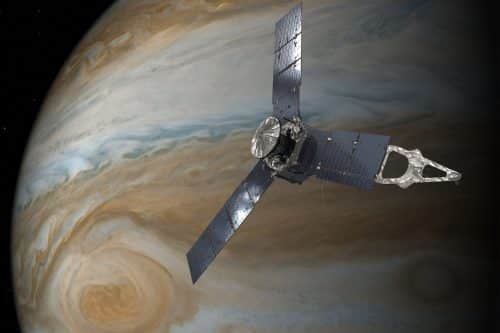The roots of Jupiter's giant storm, which is 1.3 times the diameter of the Earth, penetrate to a depth of about 300 km below Jupiter's outer atmosphere, as shown by the initial findings from the flyby of the Juno probe over the Great Red Spot last July

The Juno probe, which studies the largest planet in the solar system, Jupiter, discovered that the roots of its famous big red spot reach a depth of about 300 km. The probe also found a previously unknown radiation belt, consisting of energetic particles moving at a speed close to the speed of light, and near the top of Jupiter's atmosphere. NASA researchers revealed the new findings at the American Geophysical Union (AGU) conference, which was held yesterday (Monday) in New Orleans.
Juno passed for the first time above the Great Red Spot on July 10, 2017, about a year after it entered orbit around the planet on July 4, 2016. During the flight, the spacecraft reached an altitude of about 3,400 km above Jupiter's cloud cover, and was able to study very closely the roots of the giant storm , something that could not be done with distant observations of telescopes on Earth.
"One of the most fundamental questions about Jupiter's Great Red Spot is: How deep do its roots go?" said Juno principal investigator Scott Bolton of the Southwest Research Institute in San Antonio, Texas. "The information from Juno indicates that the most famous storm in the solar system is almost the width of one and a half Earths, and has roots that penetrate approximately 300 km into the planet's atmosphere."
The information that enabled the new discovery from the mysterious and distant world was collected using Juno's Microwave Radiometer (MWR). The device has six separate antennas, each of them sensitive to a different microwave frequency, which penetrate to different depths in the atmosphere of Jupiter, thus making it possible to reveal the composition and internal structure of the twirls and storms visible above the atmosphere of Jupiter, which is a gas giant with no solid ground.
Watch: A fascinating simulation video showing Juno's "dive" above Jupiter's Great Red Spot
The Great Red Spot is perhaps the most familiar feature of Jupiter, and has been observed regularly on the planet since 1830, although astronomers may Giovanni Cassini Watched it already more than 350 years ago, In 1665. The "spot" is an oval storm that rotates counter-clockwise. Similar to hurricanes on Earth, the center of the storm is relatively calm, but the outer parts are windy Arriving For speeds higher than any storm on earth, between 430 and 680 km/h. The width of the storm, as of April 2017, was about 16,000 km, or about 1.3 times the diameter of the Earth.
"Juno found that the roots of the Great Red Spot are 50 to 100 times deeper than Earth's oceans, and are hotter at the base than at the top," said Andy Ingersoll, a professor of planetary sciences at Caltech and a co-investigator on the Juno mission. "Winds are related to differences in temperature, and the heat at the base of the spot explains the strong winds up in the atmosphere."
One of the remaining mysteries about the Great Red Spot is how it will evolve in the future. While in the 19th century the width of the giant storm was well over 2 times the diameter of the Earth, in the modern era it has begun to shrink. In 1979, when the two Voyager spacecraft passed near Jupiter, the Great Red Spot was twice the diameter of the Earth, and today, as mentioned, measurements made by telescopes on Earth show that compared to its size in the 2s, its width has shrunk by a third and its height is smaller by an eighth .

Another finding that Juno revealed is a radiation belt that was not known until now, and is very close to Jupiter. The belt consists of energetic hydrogen, oxygen and sulfur ions (atoms with an electric charge), moving at speeds close to the speed of light, and is located just above Jupiter's outer cloud cover.
Jupiter has the strongest magnetic field in the solar system, other than that of the sun itself. similarly For Van Allen radiation belts of the Earth, the magnetic field traps energetic particles, such as protons and electrons, and accelerates them to extremely high speeds. Because Jupiter's magnetic field is so strong, its radiation belts make its environment extremely dangerous, both for living things and for spacecraft with sensitive electronic components.
The strong radiation around Jupiter is one of the reasons for Juno's elliptical orbit - at the farthest point from Jupiter it reaches a distance of millions of kilometers from it, while at the closest point it reaches a distance of only about 3,400 km above the cloud cover. Due to the nature of the elliptical orbit, the spacecraft's flybys near Jupiter, once every 53 days, are carried out very quickly, thus Juno passes through the radiation belts as quickly as possible, in order to protect its electronic components. It was this close proximity to the atmosphere during flybys that allowed Juno to discover the new radiation belt that juts out just above Jupiter's outer atmosphere.
"The closer you get to Jupiter, the weirder things get," said Heidi Becker, of NASA's Jet Propulsion Laboratory, who leads the radiation monitoring experiment on the Juno mission. "We knew that the radiation would probably surprise us, but we did not know that we would discover a new radiation zone so close to the planet. We only discovered this thanks to Juno's unique trajectory, which allows it to get very close to the cloud cover during flybys to collect scientific information, and we simply passed through this area."

The researchers believe that the source of the particles in the radiation belt that was discovered are energetic neutral atoms, i.e. atoms without electric charge moving at high speed, which come from the gas around Jupiter's moons Io and Europa. The neutral atoms later lose their electrons in a collision with Jupiter's upper atmosphere, becoming electrically charged ions.
A third discovery revealed yesterday from the Juno mission is a population of very heavy and energetic ions, within one of the well-known radiation belts of Jupiter, which until now the researchers believed to be composed mainly of "relativistic electrons", i.e. those moving at a speed very close to the speed of light.
Earlier this year, NASA researchers published the The main findings from the Juno mission, designed to study Jupiter's internal structure, atmosphere, magnetic field and auroras. Among the main discoveries of the spacecraft: a huge core in the center of Jupiter, but one that is "fuzzy" and there is no clear separation between it and the layer of hydrogen above it; Much diversity in the depths of Jupiter's atmosphere, contrary to what researchers have thought so far; a mysterious emanation of ammonia, rising from the depths of the atmosphere in the equatorial region; A chaotic structure of storms at the poles that contrasts with Jupiter's orderly bands at more equatorial latitudes; and that the region in the depths of the planet, where its powerful magnetic field is created, is closer to the surface than expected.

Juno will continue to make flybys close to Jupiter at least until July 2018, then the funding for its main mission from NASA will end, although it is very likely that NASA will decide to extend the activity of the expensive spacecraft, whose total cost is estimated at about 1.1 billion dollars, into a continuation mission.
For a message on the NASA website
See more on the subject on the science website:
- A wonderful new world: the Juno spacecraft reveals Jupiter as we have never known it
- Juno passed over Jupiter's Great Red Spot for the first time
- Is Jupiter's Great Spot causing its upper atmosphere to warm?
- The Great Red Spot on Jupiter is shrinking
- Due to fear of engine failure - Juno will remain in an initial and prolonged orbit around Jupiter

One response
Need more information